Mike Kelley said for years that he would agree to be profiled in Artillery. That was practically a running joke when we would see each other at art events. Finally, in early November 2011, I contacted him to make it happen. He emailed to say he was very busy but he “decided to make some time to do the interview.”
I only found out later that our meeting was one of the last loose ends he attended to before he turned to his final act; a suicide that shocked the art world in January 2012. I had prepared the interview and we ran it on the cover of the magazine that same month, having no inkling that, by the time it hit the stands only two weeks later, the article would already be tragically out of date.
I was stunned by his death, but when I looked back over my notes there were clear hints of his depression and even of his intention. He said, “I trusted you and talked, for the first time in print, about my private life and background, because I thought it might clarify what I do in a personal way.” This was in an email dated December 23, 2011, a little over one month before he took his own life. In the interview, his last statement was particularly haunting: he planned to “stop making art,” for a few years.
I set my notes aside to join Mike’s many friends and admirers in mourning the loss of a great talent and force in the art world, particularly the Los Angeles art scene. But there is no escaping the fact that his remarks to me took on much more significance after his demise; they became his last testament.
I’ve held onto them in silence, but now, on the occasion of this first major posthumous retrospective, at MOCA, we are printing the outtakes—passages that were left out of the original profile, in verbatim excerpts. He talks about his past, his work and the market. All is colored with his yen for recognition and his struggle for integrity and meaning. It feels to me that you can also hear his depression, his sadness. But perhaps that’s just me. These are his words; you can decide for yourself.
THE VIETNAM WAR
I was not going to go. There was no doubt about it. I was not going to go to Vietnam. The Vietnam war promoted my anti-Americanism. It was horrible. And I was not going to go. I would do anything.
I could have been sent off any time. The big thing for me was, what would I do? Back then everyone just went to Canada, so I was just waiting to move to Canada.
Kelley wanted me to know how strongly he felt about it. I pointed out that leaving the country, to Canada presumably, really wasn’t that big of a deal if one was already living in Detroit. We laughed at that.
NOISE MUSIC/CALARTS
The main reason I went to CalArts was for Morton Subotnick. He’s a major, major early electronic composer, he taped collage from electronics. I’d been in Destroy All Monsters and we were doing noise music; I really wanted to work with an avant-garde. I wanted to learn about that, because I was doing a street version of it.
But then I was very let down because when I got to CalArts, it wasn’t so easy. They always claimed it was a cross-genre school, but in actuality it was very difficult to work across genres. So when I was there, I never got to work with him.
I had no musical training and they said no you can’t study in the music department; you have to have a musical background—which shocked me! Because I thought it was supposed to be a cross-genre place. Like what difference does it make if you’re doing tape collage, if you have musical training or not? Or I could learn it there. I assumed I could learn these things.
But you know, on the other hand, the general faculty I didn’t connect with, but a lot of the visiting faculty I really connected with. So, it was good. It really was the best place I could have gone, because I got to meet all these professional artists. They were just like me. They were completely living in poverty—they were living in their studios. They were professional artists and they were smart people. Some of them really became my friends, like David Askevold, he was a really, really great teacher and Laurie Anderson, Douglas Huebler. These people were very important to me.
LA vs. NYC
I was always shocked when I moved here about the hatred of New York for Los Angeles. I couldn’t understand it, like, why bother? But, it’s to keep themselves the center. And one thing I knew when I was young, I was not going to move to New York because of this attitude. I didn’t like it. There are art centers all over the world. And New York just pissed me off. Because you know, Detroit is not a second city, it’s the fourth city. So, I go there and visit New York, and yeah, it’s great place, but: A) I can’t afford to live there. And B) I don’t like this fuckin’ ’tude. And so, I wanted to go to LA. I didn’t know anything about it. You know, just go check it out. And I ended up staying—it wasn’t my plan.
CalArts was kind of a school to ready you to go to New York. It was completely New York–oriented. Everyone went immediately to New York City once they graduated. Instead, I was driving into the city [LA] and checking it out and discovering a really interesting art scene. So when I [got] to LA, I was super-impressed with the work being done here. I didn’t know anything about the history of it. I knew that there were things going on here. It’s never been an art center like New York, but at the same time, there’s always been interesting art being produced here, especially in the ’70s. I think in the ’70s, LA was one of the most interesting art cities in the world. There were no museums, hardly any galleries—it just was. What was going on here was so vanguard. Like the Feminist movement and the performance art scene. Top-notch. The Conceptual art movement. I think it’s the best art-school center in the world. It had all that going for it, it just didn’t have any money. Like you can live here, you can be an artist, but you’re not going to make any money. There were only collectors left over from the ’60s, buying the same old Pop Art. Finish Fetish stuff. I had no connection with that.
And you have to remember, the ’70s was the middle of the recession, so there was no art market anyway. That’s why the ’70s are historically absent, because there was no money. So the history just ignores it because art wasn’t shown in galleries and museums. It was a dead zone economically.
CONCEPTUAL ART
Do you call yourself a conceptual artist?
I would have to say yes. No, I’m not like the archetypal conceptual artist, but that’s where I come from. My work isn’t, say, media-based. I don’t have any connection with any particular medium. My work is idea-based.
Would you call Chris Burden a conceptual artist?
Yes, definitely.
Paul McCarthy?
Yes.
Kelley looked back on his first traveling retrospective, which opened at the Whitney in 1993.
Only recently were major museums even acquiring conceptual art. I remember when I had my retrospective at the Whitney I went to the office and saw these papers about what they were going to buy, sitting on the desk. And it was the fourth Schnabel, for some outrageous amount of money and I’d said, ‘you know, do you have any conceptual art in your collection?’ No. And I said, ‘Well, for the price of this one painting—you could put it off—you could buy everything!’ [Kelley inserts with a mocking limp voice reply from a Whitney flak]: ‘Oh well, the board of directors aren’t going to get behind that.’ That’s the way it was.
HOLLYWOOD
New Yorkers, of my days, were obsessed with Hollywood—like Cindy Sherman, Robert Longo, all these people. It’s a fuckin’ factory. It has no presence here. It’s like behind closed doors. You’re going to see it on TV, like everybody else. In the movie theater. It’s not a presence. As far as [Hollywood] affecting your life, having a presence, it does not. That’s another thing. There’s this tremendous amount of money and they don’t buy art, they don’t care about art. It’s like, I have this attitude, fuck you. Go fuck yourself. They produce this crap. They have no interest in art, they have no interest in the arts.
CONTEMPORARY ART HATES YOU
I brought up one of my favorite sayings of John Waters’. I liked it so much that I made it the cover headline: Contemporary Art Hates You. I asked Mike if he agreed.
Yes, that’s the avant-garde. What good is it? Otherwise it’s entertainment. Then there’s no reason to call it art. There’s no function for art unless it confronts you in some way or another. Art isn’t about pleasing you—that’s decoration. That’s where art’s gone wrong.
Look, 99% of people in America hate art. And then the other—it used to be a small group of fetishists—like to waste their money on these things, for ideological reasons. Now, it’s different, I think most art buyers buy things in order to turn them around and make more money. They buy art for investment, because we’re in a terrible economy, like artists are a safer bet than stocks? Or things like that. And they don’t give a shit about it. So, the people spending all that money on the art at that time were spending it because they wanted to spend it. Like it was a kind of fetish. Maybe they had guilt, for having too much money. Or how they made their money. The art becomes a way to waste your money. And something that means something to you, for some reason. And it doesn’t matter what it is.
GAGOSIAN GALLERY
Late in his career, Kelley landed with the richest gallery in the world. When he talked about it, it was clear he felt conflicted about his decision to leave Metro Pictures.
Larry Gagosian, I know, doesn’t care about my work. I don’t think any work—he’s a businessman. It’s like, you’re there as long as he can make money off you. So, it’s not a familial place, like other galleries I’ve been in. And, it’s just, that’s the way the world’s gone. It’s like, either I take this chance or forget about it. I’ll always be where I’m at. Who knew?
Kelley pushed the boundaries of commercial taste when he exhibited his film installation, “Day is Done,” with Gagosian in New York in 2005.
I expected it to be a failure and it wasn’t. So, that led to this ongoing relationship with Gagosian Gallery. Gagosian Gallery, like I said, no long-term commitment there. You’re there as long as you make money. And then you’re out. You’re out the door—boom. But at least, maybe that’s better than being someplace and being stuck. It’s like, okay, you can have your show every year for 50 years. But I don’t know, I saw other artists just getting bigger and bigger and bigger. I’m competitive just like anybody else. Why not me? So I might as well take a chance. That’s all. And when it fails, I’ll just go back to doing what I did.
I’m making things now that are expensive and complicated, because I have the opportunity to do that. And when that opportunity is gone, you know, you can make art out of tissue paper. You can make art out of anything. You don’t need money to make art.
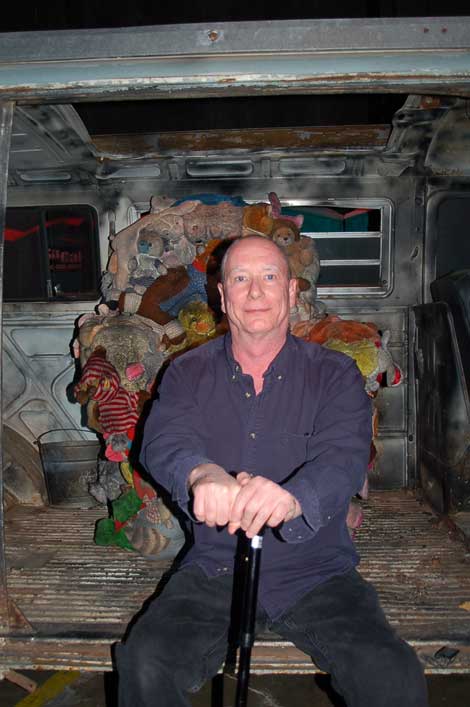
Mike Kelley at his Eagle Rock “A Voyage of Growth and Discovery” exhibit in collaboration with Michael Smith, May 2010, photo by Lynda Burdick
MOVIES
Are you still interested in making movies?
Yes, I really like making videotapes, but I lose money on them. And I have to make other things to pay for them. And so, I don’t know, it’s a kind of vanity thing, and I really like making them, and I’m thinking of stopping, because [pause] it forces me to think about the economics of what I do. In order to pay for these things that make no money, I have to come up with things that do. And, um, I’m a little tired of being in that position.
I suggest making cheaper movies.
“Well, I make them as cheaply as I can for the quality that I want. By movie standards, they’re inexpensive. But still, we’re talking like $80,000, and that’s a lot of money.
THE END
Kelley was trying to express something deeper than where I wanted to go. He even asked for more questions. But after what he said, I was too shocked and just brushed it off.
I’ve been working nonstop for years and years, and now I’m not in the mood to make art. I’m trying to slow down. I have a lot of things I have to do, you know, like this big survey show that’s coming up in 2012, it’s traveling. And some other shows that have been scheduled for a long time. I just did two shows this year, and big-scale shows. So, I just want to stop… for a couple of years.
“Mike Kelley” runs thru July 28, 2014 at The Geffen Contemporary at MOCA in Los Angeles; moca.org






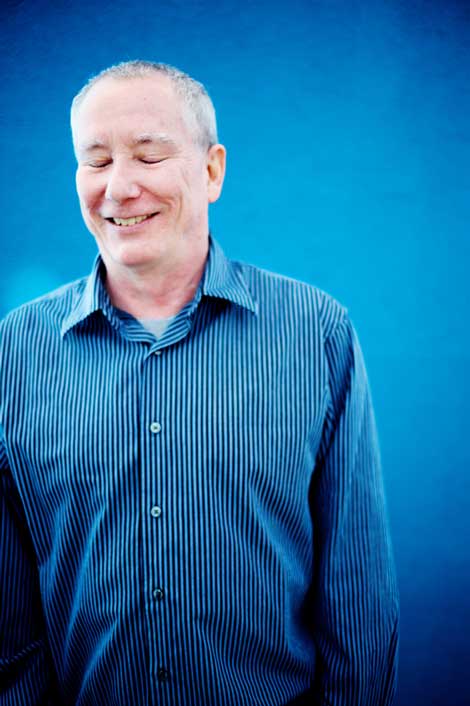

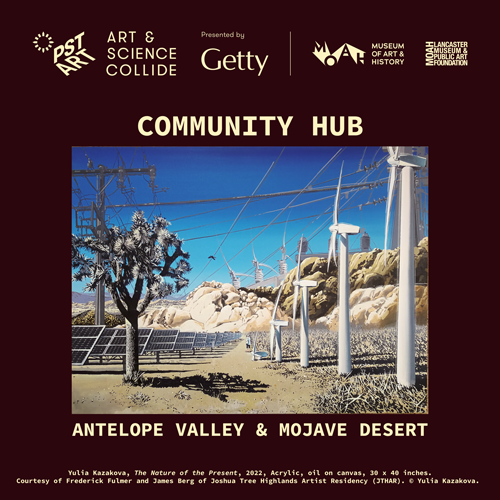

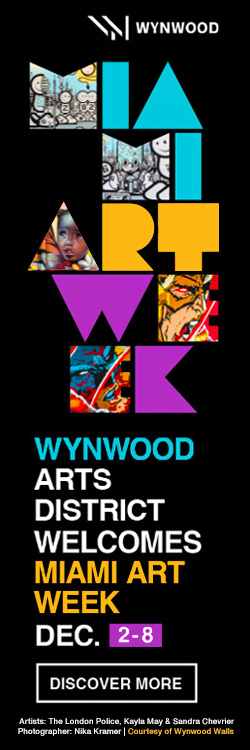
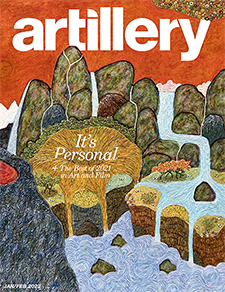
0 Comments